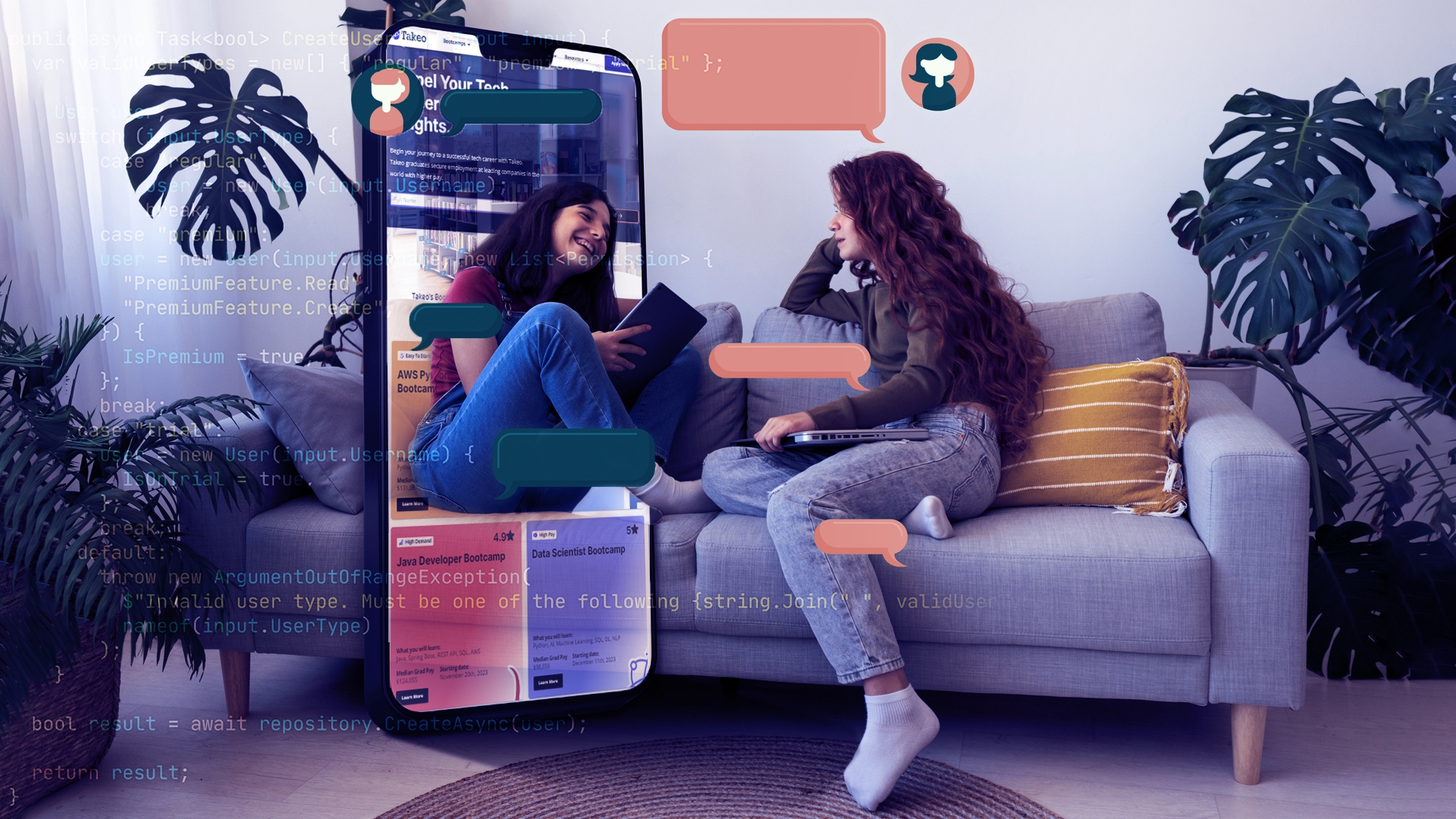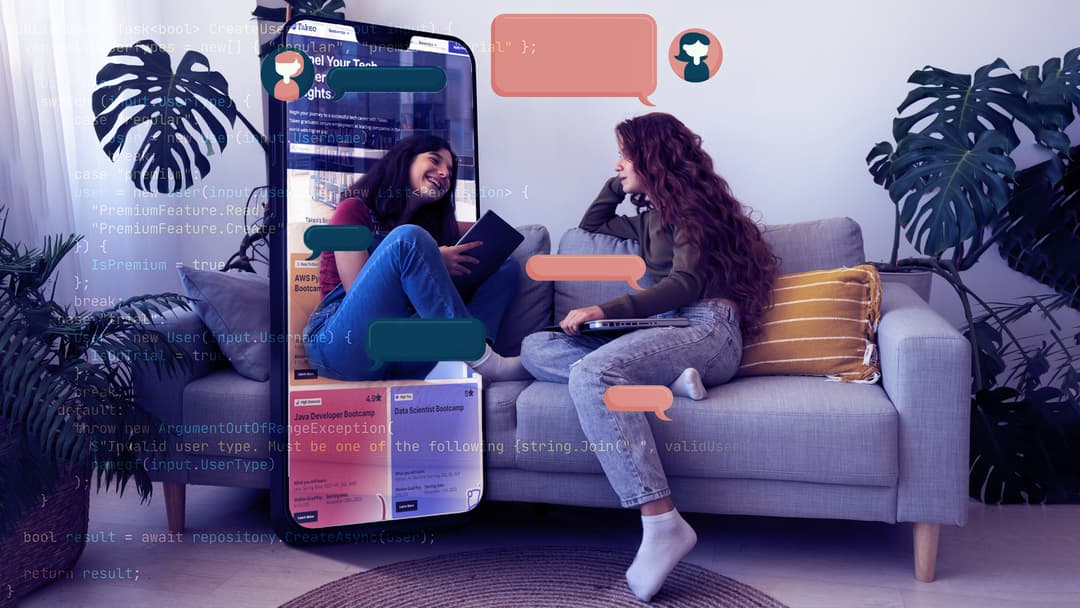
Networking for Front-End Bootcamp Grads: Online vs. In-Person
October 6th, 2023
Networking & Branding
Takeo

October 6th, 2023
Networking & Branding
Takeo
Discover the ideal networking approach for front-end bootcamp graduates. Make informed connections for your career success!
Bootcamps for front-end developers are now a well-liked entry point into the field of web development. Especially, these intense, quick workshops give participants the information and abilities to launch a front-end development career.
However, completing a bootcamp is only the first stage. Further than that, networking is the next most crucial thing if you want to develop in your profession, obtain your ideal job, and make connections in the field.
Particularly, after graduating from a front-end development bootcamp, the main decision of graduates is whether to prioritize online or in-person networking. So, in this blog, we'll examine both strategies' benefits and drawbacks to assist you in deciding which one is ideal for you.
The Power of Networking for Front-End Developers
Let's first comprehend why networking is crucial for front-end developer bootcamp grads before being into the discussion of online versus in-person networking.
We've demonstrated the importance of networking for front-end developers. Now, let's explore the advantages and disadvantages of online and in-person networking.
Online Networking: The Digital Advantage
1. Accessibility
Accessibility is one of the main benefits of online networking for recent graduates of front-end development bootcamps. No matter where you are, you may connect with peers and professionals anywhere in the world. This reach is particularly helpful if you live in a region with little presence in the IT sector.
2. Diverse Opportunities
You have access to a wide range of options through online networking. Through it, you can interact with professionals from different backgrounds, organizations, and sectors by joining forums, social media groups, and platforms like LinkedIn. Also, you may find new work opportunities, initiatives, and partnership opportunities as a result of this variety.
3. Time Flexibility
Online networking gives you the freedom to connect whenever it suits you. You can interact with your peers, discuss your work, and ask for guidance whenever it's convenient for you, whether you're a morning person or a night owl. Therefore, this versatility takes into account various timetables and time zones.
4. Portfolio Showcase
Your work is your finest portfolio as a front-end developer Bootcamp graduate. You may promote your work on websites, code repositories, and other online platforms, offering prospective employers and colleagues a clear idea of your abilities and sense of style.
5. Learning Resources
Online networking frequently includes a variety of educational materials. To keep learning new things, you may take part in webinars, online classes, and coding competitions. Through the internet, you can find a lot of business experts who give helpful tips, lessons, and best practices, and get a chance to connect with them.
In-Person Networking: The Human Connection
1. Face-to-Face Interaction
Face-to-face contact is something that in-person networking provides that internet interactions can't quite match. When you meet them in person, it's easier to communicate your excitement, passion, and personality. These close ties with people can leave a lasting effect.
2. Local Community Engagement
You may make a name for yourself in the local IT community by attending conferences, meetings, and seminars. If you're looking for employment prospects in your neighborhood, this is very helpful. Therefore, you should know that referrals and recommendations might come through local networking.
3. Immediate Feedback
Attending networking events in person allows you to get rapid feedback on your efforts. In-person experiences offer timely insights and helpful feedback, whether it's a work review or a code reviewing session.
4. Collaboration Opportunities
Meetings in person generally result in chances for collaboration. You could run into possible mentors, co-founders, or even project partners. These collaborations will eventually advance your career and assist you in learning new skills.
5. Industry Insights
Attending events targeted toward your sector, such as conferences and seminars, may provide you with a comprehensive understanding of the newest trends and innovations. Keynote speakers and discussions on panels can teach you things that you wouldn't learn otherwise.
The Hybrid Approach: Finding Balance
While the debate between online and in-person learning keeps going, some front-end developer bootcamp graduates succeed by using a mixed strategy. Here are some tips for finding the right mix between in-person networking and Internet networking:
1. Build an Online Presence
Specifically, make a solid online presence as your first step. Publish your creations on sites like GitHub, establish a credible LinkedIn profile, and interact with IT groups on social media. To Stay up-to-date, eventually, sign up for relevant online forums and communities.
2. Attend Local Meetups
Attend regional gatherings and networking events if you live in a tech-oriented area. These events will unquestionably provide you the chance to network with local experts and make contacts that could open up career prospects.
3. Virtual Conferences and Webinars
Consider online meetings and webinars. They provide access to business expertise and the convenience of attending from home, giving the best of both worlds. Additionally, video calls for networking sessions are common during conferences.
4. Collaborative Online Projects
Subsequently, take part in online group projects. Contributing to open-source projects or working together on coding difficulties is made simple by platforms like GitHub. Your abilities will be improved and you will meet other developers who share your interests because of these meetings.
5. Personal Branding
Spend time on your personal brand. In order to share your expertise and promote your portfolio, establish a professional website. Particularly, opportunities and connections will come your way if you have a strong internet presence.
6. Alumni Networks
Furthermore, use the alumni network of your boot camp. Make connections with other recent grads who are seeking front-end development employment. Obviously, they can provide assistance, open up employment possibilities, and give guidance on the basis of their experiences.
Conclusion: Tailor Your Networking Approach
In the end, whether online or in-person networking works best for you as a front-end developer bootcamp graduate depends on your goals, location, and personal preferences. The key is to tailor your approach to your specific needs. Embrace the opportunities that both online and in-person networking offer, and continuously refine your strategy as you progress in your career.
By doing this, you'll undoubtedly increase your opportunities to get the perfect job and grow a successful front-end development career.

Welcome, dear readers, to a grand exploration of the captivating world of effective communication—a symphony of words, gestures, and nuances that shapes our personal and professional journeys. In this immersive odyssey, we will venture deep into the realms of articulation, storytelling, and persuasion, unraveling the secrets behind mastering these three pillars of communication prowess. Prepare to be enchanted as we embark on a journey to compose and conduct your very own symphony of communication mastery.
Articulation, the first movement in our communication symphony, is akin to the precision of choreography in a dance. It involves the clear and deliberate expression of thoughts and ideas—a linguistic dance that enhances credibility and professionalism.
Transform your spoken words into a rhythmic dance, engaging in the art of public speaking. Whether it's a corporate presentation or a community gathering, the stage becomes your canvas to choreograph a performance that resonates with clarity and confidence.
Picture your words as dancers on a stage, each one requiring careful choreography. Enunciate with precision, allowing your message to pirouette through the air, leaving a lasting impression on your audience.
Seek Feedback for Continuous Improvement:
Treat feedback as the mirror reflecting your linguistic dance. Embrace constructive criticism as a means to refine your steps, ensuring that each word and gesture is a deliberate movement in the art of articulation.
Step into the enchanting realm of storytelling, where the stage transforms into a narrative ballet—a captivating dance that goes beyond the confines of ordinary communication. This isn't just a dialogue; it's a choreography of words that weaves an intricate and immersive experience. Each word becomes a dancer, gracefully pirouetting through the minds of the audience, leaving an indelible mark. The narrative ballet transcends the boundaries of traditional communication, creating a profound and emotional connection that resonates with the hearts of those who partake in this lyrical journey of tales and emotions.
Imagine your story as a well-choreographed dance routine, with a clear beginning, middle, and end. Craft a narrative that flows seamlessly, leading your audience through a captivating journey.
Dive into the pool of emotions like a graceful dancer taking center stage. Create a bond that goes beyond words, allowing your audience to feel the ebb and flow of your story on a visceral level.
Paint the canvas of your narrative with vibrant colours and intricate details. Let your words be the dancers that pirouette through the minds of your audience, creating a visual and emotional spectacle.
Treat your story as a thematic dance, with each movement representing a key message. Clearly define the central themes, ensuring that your narrative resonates harmoniously with your communication goals.
Adapt your storytelling style to different stages, much like a versatile dancer shifting between genres. Whether it's an intimate conversation or a grand presentation, let your storytelling dance captivate diverse audiences.
Infuse authenticity into your storytelling, making it a genuine and relatable dance. Anecdotes and real-life examples become the dance steps that ground your narrative in the reality of shared experiences.
As we progress through our communication symphony, persuasion emerges as the grand crescendo—a powerful movement that involves building trust, appealing to emotions, and presenting arguments with a convincing finesse.
Imagine trust as the steady beat that underlies every persuasive argument. Establish your credibility like the strong foundation of a classical composition, creating a platform from which your persuasive melody can soar.
Persuasion is a dance between the heart and the mind. Evoke emotions that resonate with your audience, allowing the logical arguments to be the melodic strains that carry them away on a persuasive journey.
Envision persuasion as a dance duet where finding common ground is the shared melody. Discover harmonious notes that resonate with your audience, creating a connection that forms the backbone of your persuasive choreography.
Support your persuasive arguments with the robust foundation of evidence and data. Let them be the powerful chords that lend credibility and weight to your persuasive symphony.
Anticipate objections with the grace of a seasoned dancer anticipating twists and turns. Address counterarguments with finesse, turning potential discord into a harmonious resolution that guides your audience through the intricacies of your persuasive dance.
Picture honesty as the spotlight that illuminates your persuasive performance. Illuminate your message with transparency, ensuring that the ethical spotlight shines brightly on your persuasive dance.
Embrace the diversity of opinions like a dance that incorporates various styles. Let the symphony of your persuasion be inclusive, respecting the different notes that contribute to the richness of the composition.
As we navigate deeper into the intricacies of effective communication, a dynamic interplay emerges—a symphony wherein articulation, storytelling, and persuasion dance in unison. Picture these skills as instruments in an orchestra, each contributing to a harmonious melody that resonates with your audience. It's crucial to recognize the interconnected nature of these elements, forming a symphony of communication that orchestrates a seamless and impactful experience.
Now, let's open the door to the world of communication virtuosos. These individuals, like skilled conductors, effortlessly blend articulation, storytelling, and persuasion. Imagine having backstage passes to witness their masterful performances—the true magic of integrated communication. This isn't just a show; it's a front-row seat to the artistry of conveying ideas with precision, crafting engaging narratives, and persuading with finesse. So, grab your pass and step into a realm where communication becomes an enchanting symphony that captivates and resonates.
Imagine your communication style as a versatile melody, adapting itself to the unique tastes of different audiences. Tailor your approach whether you're harmonizing with colleagues, serenading clients, or orchestrating a symphony for the public.
Picture your words as notes that resonate differently across various platforms. Whether it's a written masterpiece, a spoken soliloquy, or a digital composition, adapt your communication style to each platform's unique rhythm.
Convey your message like a delicate ballet, minimizing the risk of misinterpretation. Encourage a dialogue where the subtle nuances of your communication can be clarified and appreciated.
Infuse your communication with the spirit of engagement. Make it a lively ballet, where your audience can't help but be entranced by the graceful movements of your message.
Tackle resistance with the grace of a skilled dancer navigating a challenging routine. Address objections not as obstacles but as opportunities to showcase the flexibility and strength of your persuasive ballet.
Dance to the rhythm of your audience's responses. Active listening is your partner in this communication ballet, allowing you to adjust your steps in real-time.
Enlist the guidance of a dance instructor, or in this case, seek feedback regularly. Constructive feedback is your dance partner's hand, guiding you toward perfection in every step.
Imagine communication as a never-ending dance class. Stay nimble on your feet, embrace the dynamic nature of communication, and adapt your dance to the ever-evolving rhythm of your audience.
Imagine your communication as a multimedia performance. Use visual aids to add a visual melody, enhancing the overall impact of your message.
Conquer the challenges of virtual communication with the finesse of a digital dancer. Utilize tools and strategies to create a seamless digital performance, ensuring your message transcends the digital divide.
Collaborate like an ensemble of digital virtuosos. Leverage digital tools to create a symphony of collaboration, where ideas harmonize seamlessly in the digital space.
Picture your communication skills as a ballet that never reaches its final curtain call. Embrace the dynamic nature of communication, recognizing that the beauty lies in the constant evolution of your balletic steps.
Envision yourself as a perpetual student in the grand school of communication arts. Encourage continuous learning, seeking out opportunities to refine your balletic steps and staying attuned to the latest rhythms of communication.
As the curtains draw to a close, let's take a bow and recap the key notes in our symphony of communication. From the precision of articulation to the emotional depth of storytelling and the convincing crescendos of persuasion, you now hold the conductor's baton to orchestrate your communication masterpiece.
As you step off the stage of this extensive exploration, let the melodies of articulation, storytelling, and persuasion resonate in your mind. Apply these skills in the grand theatre of your life, creating a communication symphony that leaves an indelible mark on every audience you encounter. Your journey towards becoming a master communicator isn't just a performance—it's an ongoing ballet that enriches your personal and professional odyssey. Now, go forth and let your communication symphony captivate the world!

Discover the benefits of attending events and meetups as a web developer: networking, learning, and staying ahead in the field.
Introduction
You must know that success in the ever-changing field of web development depends on staying up with the newest trends and technology. While a range of online resources on the internet are available for new trends, you should know that nothing will beat the in-person experience of meeting with other professionals who share your interests and knowledge of trends. Attending events and meetups as a web developer can provide you with a plethora of benefits that go beyond what you can achieve on your own. Therefore, in this blog, we will go over the numerous advantages of attending these events and how they might accelerate your web development career. So, let's get started.
Knowledge Expansion
Innovations and developments exist in the realm of web development. So to be updated with industry advancements, you can attend events and meetups. Here are some of the points-
Networking Opportunities
A great strategy for both professional and personal development is networking. By going to events and gatherings, you may make connections with a wide range of industry participants. Here's why networking matters:
Exposure to New Technologies
The field of web development is therefore always changing as fresh technologies and tools are coming day by day. A web developer can become familiar with these advances by going to events and meetups:
Professional Growth
Attending meetings and events for web development can help you advance professionally. Here's how they can contribute to your development:
Inspiration and Motivation
Eventually, developing websites may be a difficult and lonely task. It may be quite inspiring to meet other driven web developers and hear about their experiences. Here's how:
Community Building
Creating and engaging with a web development community will undeniably help you have a solid professional support system. Here's how gatherings and events might help you in this domain:
Staying Ahead of the Curve
It is not an option to remain motionless in a subject that is changing so quickly, like web development. Participating in gatherings and events may help you remain on top of trends by:
Personal Fulfillment
Participating in web development events and meetings may bring personal fulfillment in addition to benefits to one's career. Here's how:
Conclusion
To get success in this dynamic web development industry, you have to keep yourself educated, engaged, and connected. So, as a web developer, you may make significant progress in your career and personal life by participating in events and meetups without a doubt. Undoubtedly, attending these events gives you the chance to learn more, connect with business leaders in the field, anticipate new trends, and draw motivation from the achievements of others.
Ultimately, the decision to attend these events can be a game-changer for your web development journey. So, why wait? Begin researching upcoming events online or in your community, and set out on a path of ongoing improvement. Your future self will thank you.

Discover the ideal networking approach for front-end bootcamp graduates. Make informed connections for your career success!
Bootcamps for front-end developers are now a well-liked entry point into the field of web development. Especially, these intense, quick workshops give participants the information and abilities to launch a front-end development career.
However, completing a bootcamp is only the first stage. Further than that, networking is the next most crucial thing if you want to develop in your profession, obtain your ideal job, and make connections in the field.
Particularly, after graduating from a front-end development bootcamp, the main decision of graduates is whether to prioritize online or in-person networking. So, in this blog, we'll examine both strategies' benefits and drawbacks to assist you in deciding which one is ideal for you.
The Power of Networking for Front-End Developers
Let's first comprehend why networking is crucial for front-end developer bootcamp grads before being into the discussion of online versus in-person networking.
We've demonstrated the importance of networking for front-end developers. Now, let's explore the advantages and disadvantages of online and in-person networking.
Online Networking: The Digital Advantage
1. Accessibility
Accessibility is one of the main benefits of online networking for recent graduates of front-end development bootcamps. No matter where you are, you may connect with peers and professionals anywhere in the world. This reach is particularly helpful if you live in a region with little presence in the IT sector.
2. Diverse Opportunities
You have access to a wide range of options through online networking. Through it, you can interact with professionals from different backgrounds, organizations, and sectors by joining forums, social media groups, and platforms like LinkedIn. Also, you may find new work opportunities, initiatives, and partnership opportunities as a result of this variety.
3. Time Flexibility
Online networking gives you the freedom to connect whenever it suits you. You can interact with your peers, discuss your work, and ask for guidance whenever it's convenient for you, whether you're a morning person or a night owl. Therefore, this versatility takes into account various timetables and time zones.
4. Portfolio Showcase
Your work is your finest portfolio as a front-end developer Bootcamp graduate. You may promote your work on websites, code repositories, and other online platforms, offering prospective employers and colleagues a clear idea of your abilities and sense of style.
5. Learning Resources
Online networking frequently includes a variety of educational materials. To keep learning new things, you may take part in webinars, online classes, and coding competitions. Through the internet, you can find a lot of business experts who give helpful tips, lessons, and best practices, and get a chance to connect with them.
In-Person Networking: The Human Connection
1. Face-to-Face Interaction
Face-to-face contact is something that in-person networking provides that internet interactions can't quite match. When you meet them in person, it's easier to communicate your excitement, passion, and personality. These close ties with people can leave a lasting effect.
2. Local Community Engagement
You may make a name for yourself in the local IT community by attending conferences, meetings, and seminars. If you're looking for employment prospects in your neighborhood, this is very helpful. Therefore, you should know that referrals and recommendations might come through local networking.
3. Immediate Feedback
Attending networking events in person allows you to get rapid feedback on your efforts. In-person experiences offer timely insights and helpful feedback, whether it's a work review or a code reviewing session.
4. Collaboration Opportunities
Meetings in person generally result in chances for collaboration. You could run into possible mentors, co-founders, or even project partners. These collaborations will eventually advance your career and assist you in learning new skills.
5. Industry Insights
Attending events targeted toward your sector, such as conferences and seminars, may provide you with a comprehensive understanding of the newest trends and innovations. Keynote speakers and discussions on panels can teach you things that you wouldn't learn otherwise.
The Hybrid Approach: Finding Balance
While the debate between online and in-person learning keeps going, some front-end developer bootcamp graduates succeed by using a mixed strategy. Here are some tips for finding the right mix between in-person networking and Internet networking:
1. Build an Online Presence
Specifically, make a solid online presence as your first step. Publish your creations on sites like GitHub, establish a credible LinkedIn profile, and interact with IT groups on social media. To Stay up-to-date, eventually, sign up for relevant online forums and communities.
2. Attend Local Meetups
Attend regional gatherings and networking events if you live in a tech-oriented area. These events will unquestionably provide you the chance to network with local experts and make contacts that could open up career prospects.
3. Virtual Conferences and Webinars
Consider online meetings and webinars. They provide access to business expertise and the convenience of attending from home, giving the best of both worlds. Additionally, video calls for networking sessions are common during conferences.
4. Collaborative Online Projects
Subsequently, take part in online group projects. Contributing to open-source projects or working together on coding difficulties is made simple by platforms like GitHub. Your abilities will be improved and you will meet other developers who share your interests because of these meetings.
5. Personal Branding
Spend time on your personal brand. In order to share your expertise and promote your portfolio, establish a professional website. Particularly, opportunities and connections will come your way if you have a strong internet presence.
6. Alumni Networks
Furthermore, use the alumni network of your boot camp. Make connections with other recent grads who are seeking front-end development employment. Obviously, they can provide assistance, open up employment possibilities, and give guidance on the basis of their experiences.
Conclusion: Tailor Your Networking Approach
In the end, whether online or in-person networking works best for you as a front-end developer bootcamp graduate depends on your goals, location, and personal preferences. The key is to tailor your approach to your specific needs. Embrace the opportunities that both online and in-person networking offer, and continuously refine your strategy as you progress in your career.
By doing this, you'll undoubtedly increase your opportunities to get the perfect job and grow a successful front-end development career.
